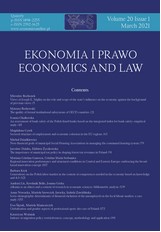Regional innovation performance and structural conditions in Central and Eastern Europe: embracing the broad-based innovation concept
Regional innovation performance and structural conditions in Central and Eastern Europe: embracing the broad-based innovation concept
Author(s): Mariana Cristina GĂNESCU, Cristina ŞerbănicăSubject(s): National Economy, Regional Geography, Government/Political systems, Comparative politics, Socio-Economic Research
Published by: Wydawnictwo Naukowe Uniwersytetu Mikołaja Kopernika
Keywords: regional innovation performance; broad-based innovation; structural conditions; Central and Eastern European regions;
Summary/Abstract: Motivation: There is plenty of evidence suggesting that the (regional) innovation systems in Central and Eastern Europe (CEE) are in their early beginnings and that this poses huge challenges to the implementation of the smart specialization agendas and to the efficient use of the European structural and investment funds in these countries. Our assumption is that structural differences explain to a large extent the differences in innovation performance between the CEE and non-CEE regions and that the future growth trajectories of the CEE regions should more specifically embrace the broad-based innovation concept. Aim: Our study attempts to test whether there are statistically significant differences between the CEE and non-CEE regions in each component of the European Regional Innovation Scoreboard and whether such differences can be explained by the variations in structural conditions. To this purpose, we use a discriminant factor analysis and test the correlations between the discriminant function and various structural indicators. Results: The R&D-based component of the regional innovation systems discriminates the most between the CEE and the non-CEE regions. In contrast, the differences between the two groups are minimal in terms of Non-R&D innovation expenditure, Tertiary education or Employment in Medium and High-Tech Manufacturing. On the whole, the differences in innovation performance, as reflected by the discriminant function, can be largely attributed to the differences in economic performance (GDP per capita) and in the industrial structures. All these considerations give support for the adoption of the broad-based innovation policy at the CEE level, which goes beyond the R&D investments and gives widespread support to both technological and non-technological innovation, skills upgrading or the integration into international networks and value chains.
Journal: Ekonomia i Prawo. Economics and Law
- Issue Year: 20/2021
- Issue No: 1
- Page Range: 107-120
- Page Count: 14
- Language: English

